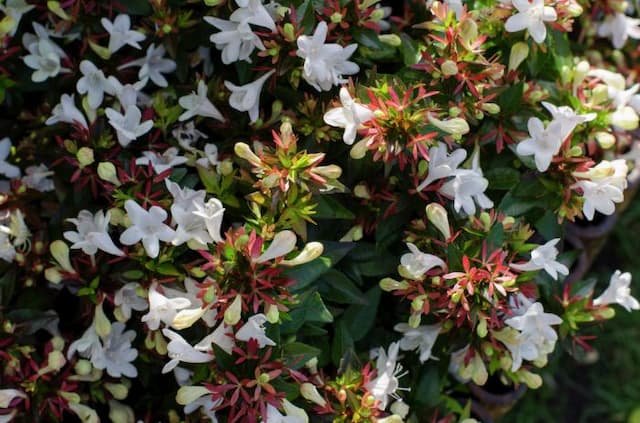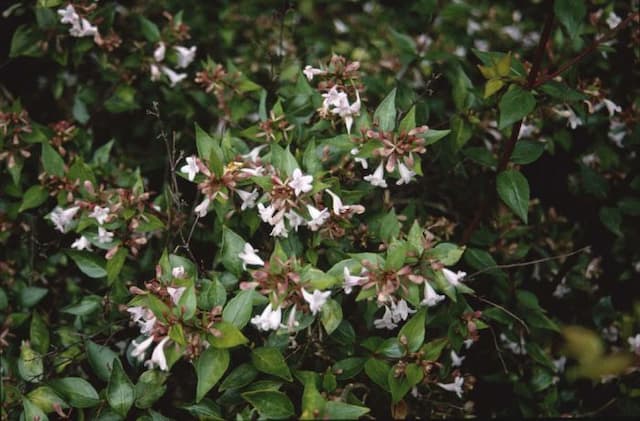American Honeysuckle Lonicera × americana (Mill.) K. Koch

ABOUT
Lonicera × americana, commonly known as American honeysuckle, is a hybrid species of the honeysuckle family. This ornamental plant is characterized by its striking flowers and lush foliage. The flowers bloom in beautiful shades, typically a mix of pink, white, and yellow hues, which transition in color as they mature. They are tubular in shape and often have a sweet fragrance that attracts pollinators like bees and hummingbirds. The leaves of American honeysuckle are oval to oblong in shape, with a pointed tip, and they display a lush green color. The foliage can create a dense and leafy appearance, adding to the visual appeal of the plant in a garden setting. During the flowering season, which occurs in late spring to early summer, the plant becomes a focal point due to its vibrant and colorful blooms. The vine of the American honeysuckle is known for being quite woody and has a twining habit, which makes it suitable for growing on structures like trellises, arbors, or fences. The plant's climbing nature allows it to add vertical interest to gardens and landscapes, often used to cover walls or to provide a natural screen. This plant typically thrives in well-drained soil and tends to prefer sunny locations, but it can also tolerate partial shade. The beauty of American honeysuckle lies not only in its flowers and foliage but also in its ability to add a romantic and whimsical touch to its surroundings. As it can grow vigorously under the right conditions, it requires some maintenance to keep it under control and looking its best.
About this plant
 Names
NamesFamily
Caprifoliaceae
Synonyms
American Woodbine, American Honeysuckle
Common names
Lonicera americana Mill., Caprifolium americanum (Mill.) Kuntze.
 Toxicity
ToxicityTo humans
The plant Lonicera × americana, commonly known as American Fly Honeysuckle, does not have a well-documented profile of toxicity for humans. However, it is noteworthy that some species within the Lonicera genus, also known as honeysuckle, contain saponic glycosides, which can be toxic if ingested in large quantities. Generally, honeysuckle berries are not considered edible and may cause mild to severe gastrointestinal upset if ingested, including symptoms such as vomiting, diarrhea, and abdominal pain. Some plants within this genus could also potentially cause more severe toxicity, although specific information regarding Lonicera × americana's toxicity in humans is limited.
To pets
The plant Lonicera × americana, commonly known as American Fly Honeysuckle, is not specifically listed as toxic to pets, but since some honeysuckle species can contain harmful components like saponins, it is advised to prevent pets from ingesting parts of this plant. In general, ingestion can lead to gastrointestinal issues in pets, such as vomiting and diarrhea. If a pet consumes part of a honeysuckle plant, it is important to monitor for any signs of illness and consult a veterinarian if any troubling symptoms occur.
 Characteristics
CharacteristicsLife cycle
Perennials
Foliage type
Deciduous
Color of leaves
Green
Flower color
Yellow
Height
10 feet (3 meters)
Spread
6 feet (1.8 meters)
Plant type
Shrub
Hardiness zones
5
Native area
North America
Benefits
 General Benefits
General Benefits- Ornamental Value: Lonicera × americana, commonly known as American honeysuckle, is often used in gardens and landscaping for its attractive flowers and sweet fragrance.
- Wildlife Attraction: The plant produces nectar-rich flowers that attract hummingbirds, butterflies, and other pollinators, helping to support local ecosystems.
- Erosion Control: With its spreading habit, American honeysuckle can help stabilize soil and prevent erosion on slopes or in areas prone to soil loss.
- Privacy Screen: When planted in rows or as a hedge, American honeysuckle can provide a dense and leafy screen for privacy or as a windbreak.
- Shade Provision: Its foliage can create shaded areas in gardens, offering respite from the sun during hot summer months.
 Medical Properties
Medical Properties- This plant is not used for medical purposes.
 Air-purifying Qualities
Air-purifying QualitiesThis plant is not specifically known for air purifying qualities.
 Other Uses
Other Uses- Lonicera × americana, commonly known as American honeysuckle, can be trained to grow into topiary forms in decorative gardens, providing both aesthetic pleasure and a creative outlet for gardeners.
- The stems of American honeysuckle can be used in basketry and craft projects due to their flexibility and strength when harvested from young growth.
- The fragrant flowers of the American honeysuckle often attract pollinators and can be strategically planted to encourage pollinator activity in fruit and vegetable gardens.
- The dense foliage of this species provides a natural privacy screen in residential landscaping, ensuring seclusion and sound dampening.
- With its vigorous climbing habit, American honeysuckle can be used to cover unsightly structures, such as fences and walls, turning them into green features.
- Its twining vines can be used in live weaving projects, such as creating living archways or garden tunnels, adding a whimsical element to outdoor spaces.
- In areas prone to erosion, planting American honeysuckle can help stabilize soil with its rooting system, helping to prevent soil loss.
- Bird enthusiasts may grow American honeysuckle to serve as habitat for birds; it provides nesting sites and shelter for various species.
- During festive seasons, branches of American honeysuckle can be cut and used as fresh greenery in decorations and wreaths, for their foliage and delicate flowers.
- For educational purposes, this plant can be used to teach botany and plant biology, as it exhibits interesting traits such as twining growth and the relationship with pollinators.
Interesting Facts
 Feng Shui
Feng ShuiThe American Honeysuckle is not used in Feng Shui practice.
 Zodiac Sign Compitability
Zodiac Sign CompitabilityThe American Honeysuckle is not used in astrology practice.
 Plant Symbolism
Plant Symbolism- Love and Devotion - As a climbing plant often seen twining around structures and other plants, Lonicera × americana, commonly known as American Honeysuckle, symbolizes strong affection and the bonds of love, much like its vining habit.
- Generosity - American Honeysuckle is known for its abundant and sweet-smelling flowers which can symbolize the generous sharing of feelings and the act of giving.
- Attraction - With its fragrant flowers that attract hummingbirds and pollinators, American Honeysuckle can represent the power of attraction and the sweetness of a person’s disposition or home.
- Bonds of Friendship - Much like it supports itself on other structures or plants, American Honeysuckle can symbolize the supportive nature of friendship and the intertwining of lives.
- Protection - Historically, honeysuckle was planted near homes to ward off evil spirits and bad luck, representing protection and housing beauty.
 Water
WaterThe American Woodbine, or more commonly known as American Honeysuckle, should be watered deeply once a week, allowing for about 1 to 1.5 gallons per plant, ensuring that the root zone is thoroughly soaked. During hot or dry spells, increase watering frequency to twice a week. Always check the top inch of soil for dryness before watering; if it's dry to the touch, it's time to water. Reduce the amount in the winter to prevent waterlogging, especially if the ground is frozen or the plant is not actively growing.
 Light
LightAmerican Honeysuckle thrives in full sun to partial shade, preferring at least 6 hours of direct sunlight daily. The ideal spot would be one where the plant receives ample morning light with some respite from the intense afternoon sun, which can be achieved by situational planting, like the eastern side of a building or under the dappled shade of a deciduous tree.
 Temperature
TemperatureAmerican Honeysuckle is hardy in a range of temperatures but grows best when the temperature is between 60°F and 80°F. It can generally withstand temperatures down to about 0°F but not colder than -20°F, which is its minimum winter hardiness threshold. The plant can survive under high temperatures as long as appropriate watering and mulching are provided to keep the roots cool.
 Pruning
PruningPrune American Honeysuckle to maintain its shape, promote healthy growth, and encourage flowering. The best time to prune is late winter or early spring, just before new growth begins. Prune out any dead, diseased, or overcrowded branches, and cut back the previous year's growth by about a third to stimulate new shoots and blossoms.
 Cleaning
CleaningAs needed
 Soil
SoilAmerican Woodbine requires well-drained soil with a pH between 5.5 and 8. A mixture of loam, peat moss, and sand works well to provide nutrients and adequate drainage.
 Repotting
RepottingAmerican Woodbine, being a vigorous plant, may need repotting every 2-3 years if it's container-grown to prevent root crowding and to replenish nutrients.
 Humidity & Misting
Humidity & MistingAmerican Woodbine thrives in average humidity levels, but it is adaptable and can tolerate a range of humidity conditions typical of outdoor settings.
 Suitable locations
Suitable locationsIndoor
Place in bright, indirect light and keep evenly moist.
Outdoor
Plant in sun to part shade, water regularly.
Hardiness zone
4-9 USDA
 Life cycle
Life cycleLonicera × americana, commonly known as American Woodbine, begins its life cycle when seeds germinate in the spring, preferring a well-drained soil that retains some moisture. As a perennial, the seedlings develop into juvenile plants with vigorous growth, quickly establishing a root system and sending up shoots. Over the next several years, the plant enters its vegetative stage, maturing and expanding through climbing or sprawling, using its twining stems to secure support from surrounding structures or plants. Flowers develop and bloom in late spring to early summer, displaying yellow to pinkish-white flowers that attract pollinators and result in berry formation. The berries mature by late summer to fall, turning red or blackish and containing seeds that are dispersed by birds and other animals, promoting the spread of the species. Finally, American Woodbine enters a period of dormancy during the winter, when growth pauses until warmer spring temperatures stimulate the next cycle of growth and reproduction.
 Propogation
PropogationPropogation time
Spring-Early Summer
The American woodbine, Lonicera × americana, is typically propagated through softwood cuttings. In late spring to early summer, when new growth is mature enough yet still flexible, take cuttings about 4 to 6 inches (approximately 10 to 15 cm) long. Choose healthy, non-flowering shoots, and make a clean cut just below a leaf node. Remove the leaves from the lower half of the cutting to prevent excess moisture loss. Dip the cut end in rooting hormone to encourage root development and plant the cutting in a pot filled with a mix of peat and perlite or sand, to ensure good drainage. Keep the pot in a warm, lightly shaded area and maintain consistent moisture. Roots typically develop within a few weeks, after which the cutting can gradually be acclimated to more sunlight and eventually transplanted outdoors.









